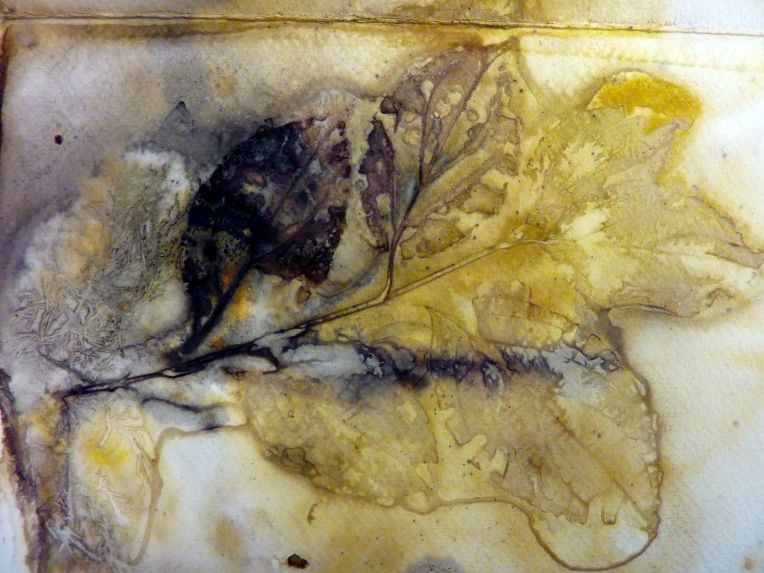At Arte Studio Ginestrelle, my studio set up for printing on paper was dependent on found materials, whatever could be repurposed for steaming papers and textiles. I used wire-mesh screen material scrunched up in a pot or a lasagna pan with a few inches of water below and a large terracotta tile for a lid. A Gypsy Campfire was not an option because we were located in the Regional Park of the Subasio and thus subject to strict forest fire controls. My heat source was propane, the same as we used in the house for cooking (when not using the wood stove). It was a simple and effective set up in an outside barn studio. With a daily temperature of around 75 degrees, that was no hardship!
A pot with wire screen bent to fit (and it makes interesting grid prints, too)
Iron bits to make rust prints; abundantly available around this former three storey farm house ( built to house a family of ten) :
…The bundles of textile or paper were for reasons of practicality on the small side. This textile bundle had been simmered in some of the plentiful walnuts strewn under the trees on the property. I usually stacked my paper bundles six sheets of papers high, weighing the stack down with a rock on top of a tile. I bundled paper and textile in thick white linen thread and used it later to sew my Artist Books, after it had taken on pigments:
I used a lot of different locally available papers, some unavailable to me here in Ottawa. To my surprise, the quality Fabriano paper known worldwide was just not available in Assisi or Perugia nearby, nor in Florence – the latter because the art supply shop was closed when we visited it. (Businesses often close from 1 – 3 pm in the afternoon as well as on Saturday and Sunday). I used thicker papers ( over 300 gms) to enclose my bundles; from these I obtained prints from pigments leaking through the stack. (Fabriano is about two hours drive from Assisi towards the Adriatic at Ancona. )
Here are some samples of my papers that were printed in the first week or so of my residency when I intentionally printed only one kind of plant on each page or between two pages. This was to enable me to judge the colours I could obtain without the colour mixing that occurs when you bundle several plants together.
Post ecoprinting, I often treat paper and textiles surfaces as paintings, taking the colours and forms in directions I choose as counterpoint to the spontanaity in colour and form that is the result of an eco print.
After printing this first set of papers, I enriched their colours in various ways: by using iron as a modifier and painting on iron liquor: by resteaming the papers with other leaves or by using the same type of leaves again and steaming them longer or under more pressure; and by applying natural dye colour (e.g., madder) as powder sprinkled on or as liquid, painted on.
These papers are in their early stages of development in the layering. Later, along with the eco printed textiles, they will be layered with embroidery and taken along other colour roads.
The grid prints are from the screen mesh and from a metal rack during the first printing. For layered colours, I made second and third printings. Rust and madder were painted on to give more colour post-printing; squishing blue coloured berries on top of the print introduced some complementary blue shades beside the yellows and oranges.
I enjoyed the “distressed” effects on some of the thinner papers caused by the high heat in the steambath and the fact that the paper sometimes tore or developed holes. The distressed surfaces and broken colours recalled for me fresco surfaces that have faded or flaked off over the centuries. These papers will form the content of more work on that “distressed fresco” theme now that I am back in my home studio.
Meantime, here are some more examples of “Little Plants of the Subasio” gathered together as pages of botanical scrolls, or destined to be:
Italian Maple (Acer opalus):
Rusted pages with Rosa canina (Wild/Dog Rose) and a “ginestrelle” seed pod:
Rust print:
Italian Maple with Oak (Quercus robur) modified with iron to give black:
Blackberry smooshed on maple:
Maple with iron:
Dogwood with iron:
Paper stack barrier sheet: with leaked colour from maple and madder.
Walnut (Jugland regia) with Dogwood berries and iron:
Walnut leaf and fern with iron:
Not sure- maybe maple…Did not take good notes on that one! The blue is Dogwood berries.
Sicilian Sumac (Rhus coraria)
Fern, Blackberry and iron:
Maple, iron and Blackberry:
Fern, maple and iron:
Collection: Maple, oak and vine leaves; blackened with iron liquor painted on, post printing.
Next time: More pages for “Little Plants of the Subasio: October Scrolls” Artist Books

































